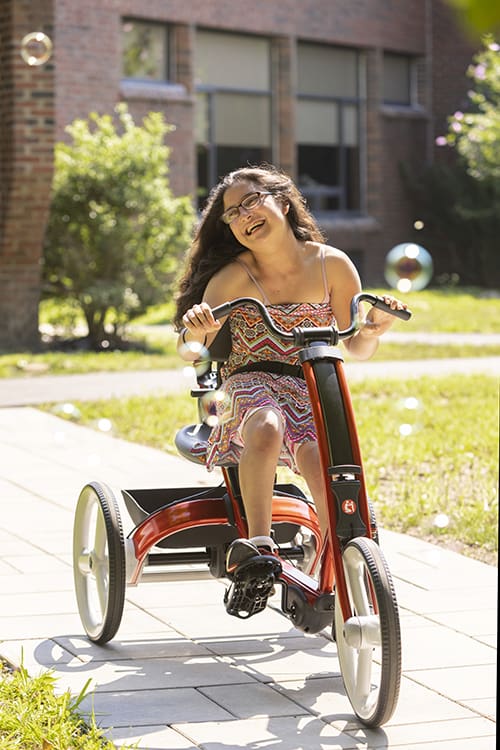EXCLUSIVE: The case for adaptive cycling – Why it should be considered essential medical equipment
Kieran Murphy, Clinical Partnerships Manager for Jenx and Jiraffe, explores some of the advantages of adaptive cycling for children with disabilities and explains why it should no longer be purely viewed as a leisure activity.
Learning how to ride a bike is a milestone many of us have fond childhood memories of. Cycling is a universal activity that’s capable of bringing plenty of joy to children with disabilities, as well as a wealth of benefits that extend far beyond recreational use.
Riding a bike is an incredibly special skill…
Enjoyed by both children and adults, cycling is widely recognised as being a fun activity, with regular bike-riding being linked to numerous health benefits, including improved cardiovascular fitness, coordination, and strength. It can also help facilitate interaction and play and, more importantly, gives children the freedom to make their way to and from school and explore new places independently.
Yet cycling rates among disabled children remain low
However, for all the benefits, research has found cycling rates among children with disabilities remain low. As for the reason, The Social Model of Disability infers that people are disabled by society rather than by their impairment, which could potentially be one of the key factors contributing to the low cycling rates.
In reality, this means that while an appropriate adaptive tricycle may be recommended for a child, it may not be funded by the local NHS services or the child’s school may not have the facilities or space to safely accommodate it. In these situations, the child is provided with an alternative mobility device instead.
Why is adaptive cycling so beneficial for children with disabilities?
According to the systematic review, ‘Efficacy of cycling interventions to improve function in children and adolescents with cerebral palsy: a systematic review and meta-analysis’, cycling therapy has the potential to improve muscle strength, balance, and gross motor function in children with cerebral palsy.
Meanwhile, a second systematic review, ‘Efficacy of Lower Extremity Cycling Interventions for Youth with Intellectual Disabilities: A Systematic Review’, found that adaptive cycling may positively impact cycling skills and cognition in children and young adults with an intellectual disability.
Despite cycling obviously being fun, adaptive bikes and trikes are wheeled mobility, sporting, and learning devices that enable independence, travel, exploration, social interaction, skill acquisition, sporting achievement, and more. And when viewed as a form of locomotion, cycling is similar to walking in relation to muscle group usage, with the neural mechanisms requiring reciprocal motor coordination. In turn, this means adaptive cycles could be considered a pre-gait or gait assisting devices.
Interestingly, guidelines published by the National Institute for Health and Care Excellence (NICE) for the management of spasticity in children under the age of 19 suggest therapy programmes should be tailored to the individual needs of the child and aimed at specific goals, such as enhancing skill development, function, and ability to take part in everyday activities. Cycling often encompasses all of these goals, which does beg the question – how are individualised and holistic approaches truly individualised and holistic, if access to adaptive cycling therapeutic devices is limited?
Encouragingly, guidance on supporting disabled children and young people to be more physically active has been developed by the UK’s Chief Medical Officers. The guidance, the first of its type, is based on the findings of a review, which clearly illustrated that disabled children and young people can benefit from being physically active in their everyday lives.
We took the guidance, alongside these exercise recommendations for children with cerebral palsy, and worked with a therapy team at a specialist school in Bury to demonstrate how easily the guidance and recommendations can be implemented into a therapy and school programme. Using our Rifton Adaptive Tricycle, we worked with two children, Harry and Brady, and recorded some incredibly positive results.

How adaptive cycling helped Harry
What we did
The Rifton Adaptive Tricycle was introduced alongside Harry’s existing therapy routine for four weeks. He took part in 20 to 30 minutes of moderate intensity cycling three to four times a week. Intensity was measured by Harry wearing a sports watch and aiming for between 50 to 70 percent of his maximum heart rate.
The result
Within the space of just a month, Harry’s resting heart reduced from 81 to 75bpm, his Paediatric Balance Scale score improved from 44 to 50 out of 56, and the distance covered over the one-minute walk test increased from 72 to 84 metres. Harry’s physiotherapist also felt there had been noticeable improvements in his gait pattern.
How adaptive cycling helped Brady
What we did
The Rifton Adaptive Tricycle was added to Brady’s existing therapy routine for six weeks. Brady took part in 20 to 30 minutes of moderate intensity cycling up to five times a week. The intensity of cycling was determined via therapist assessment and discretion.
The result
During the first assessment, Brady was unable to propel and pedal the tricycle independently and needed significant support to turn and navigate. After six weeks, he could push off and pedal, turn the tricycle independently on wider turning circles, and take part in playtime cycling groups with his peers.
The potential for adaptive cycling to help children with disabilities, is truly remarkable. The key to making sure it is widely utilised, is making sure the benefits, like those experienced by Harry and Brady, continue to be shared and discussed far and wide.



